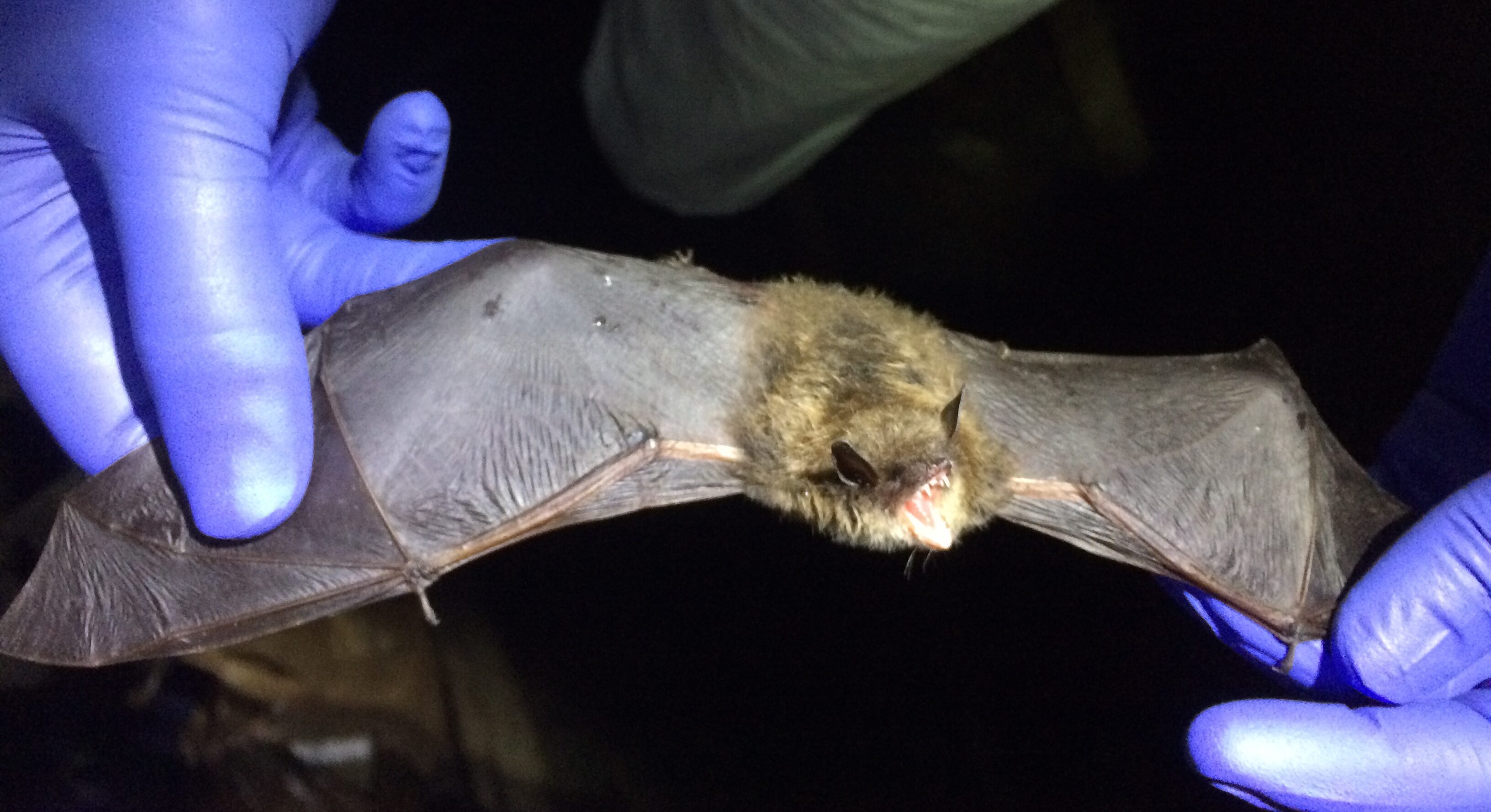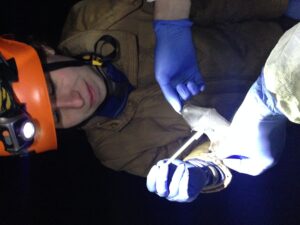
A little brown bat (Myotis lucifugus) from Williams Mine, New York, where bats have evolved mutations to resist white-nose syndrome. (Credit: Sarah Gignoux-Wolfsohn)
by Kristen Minogue
For decades, a fungal disease known as white-nose syndrome has devastated bat colonies across North America. But evolution may finally be turning in the bats’ favor. In a new study, Smithsonian Environmental Research Center postdoc Sarah Gignoux-Wolfsohn discovered genetic evidence that some bats are evolving traits that help them survive the disease—and passing those traits onto their descendants.
Bats aren’t the most charismatic animals for conservation. But in many ways, bats are the unsung heroes of our food system.
“They can eat a ton of insects,” said Gignoux-Wolfsohn. “And some of the insects that they eat are agricultural pests.” (They get bonus points in the summer for eating mosquitoes.) Bats also pollinate several popular plants, including bananas, mangoes and cashews.
The new study, published in Molecular Ecology, looked at little brown bats (Myotis lucifugus), an endangered bat species in the northeastern U.S. Once widespread, some little brown bat colonies have suffered complete wipeouts from the disease. But other colonies have managed to slowly recover, even after declines of up to 98%.

SERC postdoc Sarah Gignoux-Wolfsohn takes a sample from a bat wing in New York, to analyze its genome for helpful mutations. (Photo courtesy of Sarah Gignoux-Wolfsohn)
Gignoux-Wolfsohn, then at Rutgers University-New Brunswick, analyzed the genomes of hibernating bats in caves in New York, New Jersey and Vermont. Her coauthors first visited three caves during a 2008-2009 white-nose outbreak, taking samples from bats that died of the disease. In 2016, enough time for one or two more generations of bats to be born, the team returned to the same caves in New York and New Jersey to sample descendants of the survivors. (The original Vermont cave was closed off.)
After sampling entire genomes of bat fatalities versus survivors, the team discovered 63 mutations that could have helped bats survive. These mutations already existed in the bat colonies during the outbreak, but in low amounts. Nearly a decade later, after the outbreak had passed, the abundance of those mutations had spiked.
Evolutionary biologists call this a “soft sweep from standing genetic variation.” Unlike a hard sweep, where a brand-new mutation emerges in response to a threat, a soft sweep takes advantage of what’s already there. Soft sweeps haven’t received much attention. But because they’re faster than hard sweeps, they may prove critical for bats to stand a chance of evolving resistance.
“It usually takes a long time for new mutations to arise after an environmental change,” Gignoux-Wolfsohn said. “And so the presumption is that then, basically, everyone would die because there wouldn’t be enough time for new mutations to arise.”
However, these potentially lifesaving mutations didn’t appear where the team expected them to. Only one of the 63 they could label had anything to do with the immune system—the most obvious place for animals to evolve disease resistance. The other mutations that they could link to a specific region dealt with hibernation and metabolism.
This, Gignoux-Wolfsohn suspects, is a more direct attack on how white-nose syndrome operates.
There’s a reason bats only get white-nose syndrome during hibernation. White-nose syndrome is a fungal disease, and these fungi work best in cold weather. The fungus forces bats to burn through fat reserves more quickly while their bodies should shut down for winter.
“The bats that die from white nose actually die because they are woken up multiple times throughout the winter by the pathogen, and they use up those fat stores,” Gignoux-Wolfsohn said. “And so they essentially are dying of starvation.”
The exact function of each of the mutations isn’t clear. But links to hibernation and metabolism suggest they could help bats burn fat stores more slowly, or resist attempts to disturb their winter slumber.
Knowing which bat colonies are already evolving natural protection could help scientists prioritize which caves to treat for the fungus. But the existence of “soft sweep evolution” throws something even larger into sharp relief: Protecting diversity pays off.
Soft sweep evolution thrives by taking mutations that already exist in a colony, herd or school and amplifying them. It stands the best chance of success when it has plenty of options to work with.
“That’s another argument then for trying to, as much as possible, preserve genetic diversity in wild populations,” Gignoux-Wolfsohn said. “Because we don’t know what the next white-nose syndrome is.”

